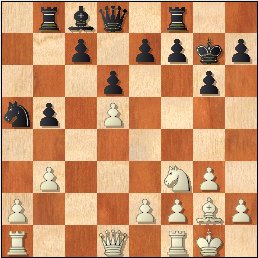
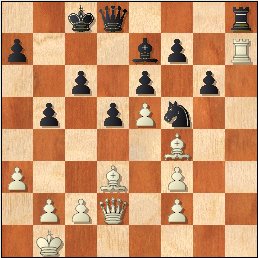
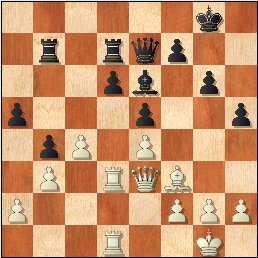
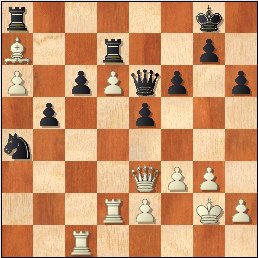
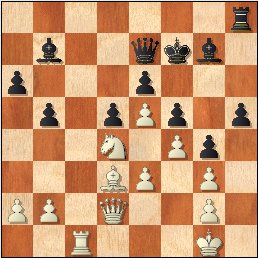
Improve your Chess via Active Learning
ACTIVE LEARNING is any strategy that involves students in doing things and thinking about the things they are doing (*)
You could study the following material either by skipping the test and going directly to the lecture. Or start by attempting to figure out on your own what is going on in each of the positions I will be talking about and then proceed to the lecture. If you chose the latter, spend time on each diagram and record your evaluation and move / plan for the side whose turn it is and sample variations. Then compare your ideas with mine. Let me know how you like the test and the lecture
Test yourself:
Level - intermediate / advanced.
1. Check whose move it is / Read the question.
2. Evaluate position (i.e. White is Better, or Black is Winning, or Equal...)
3. Find the Best move and, if necessary, support it with variations. <<CALCULATE thoroughly!!>>
4. Answer the question (if there is a specific one)
 |
 |
 |
| #1. White to Move. | #2. White to Move. | #3. White to Move. |
 |
 |
|
| #4. White to Move. | #5. White to Move. |
STOP - Lecture begins below.
Look Left, Pass Right or How to Keep the Whole Board Under Control!
Over the past couple of months I saw a few games that had one thing in common a sudden long move with the Queen, seemingly in the opposite direction to where the main battle was happening. Here is the first example: Kamsky - Ivanchuk (Sochi 2008; Diagram #3 above)
 |
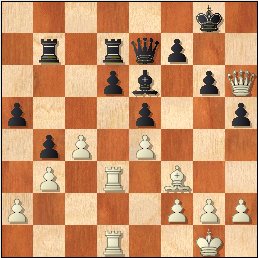 |
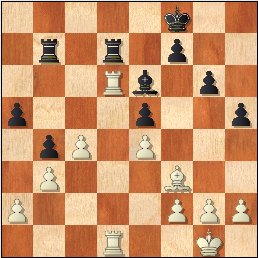 |
| #3 White to Move | 3-a Black to Move | 3-b White to Move |
It seems that the focus of this position is the d-file where Black has the backward pawn. White could try to pressure it or (at some point) breakthrough via c4-c5 and go after the weak pawns on a5, b4 and even e5. However, in response to the last Black's move 24...Rdd7, Kamsky sent his Queen deep into Black's position - 25. Qh6! All of a sudden, Black realized that White has some strong attacking options, specifically Bxh5 and Rg3. Ivanchuk decided to defuse the possible attack at once, but it cost him a pawn and soon the game. After 25...Qf8 26. Qxf8+ Kxf8 27. Rxd6, Kamsky won a healthy pawn and force resignation some 20 moves later.
Perhaps, Ivanchuk could have ignored Bxh5 by playing 25...Pa4 26.Bxh5 Qh4. White must play 27. Rg3 and it isn't very clear how he can untangle the cumbersome Queen and Bishop. I can only assume that the long (and excellent) Queen sortie caught Ivanchuk off guard, affecting his decision making.
Then I saw the following example Grischuk - Kramnik (Tal Mem, Moscow 2008; Diagram #5 above)
 |
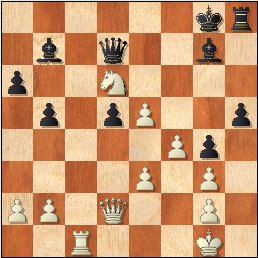 |
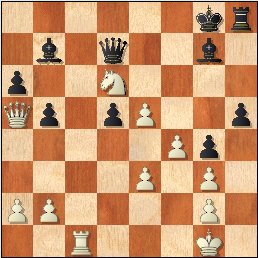 |
| #5 White to Move | 5-a White to Move | 5-b Black to Move |
White has well-placed pieces and control over the c-file. Still, the penetration on the Q-side seems out of the question as there are no entry points and Black is ready to challenge the c-file via Rc8. So, Grischuk turned his attention the other way, to the 'unbreakable' pawn wall on the K-side. After 25. Bxf5! Pxf5 26. Nxf5 Qd7 27. Nd6+ Kg8, White reached a very promising position, in spite of the slight material deficit. And now White returns his focus to the Q-side via a striking 28. Qa5, which ensures the Rook's penetration to c7. Black resigned 5 moves later.
I also found in my collection three examples with similar ideas -
The #1 White wins the pieces after 15. Qd4+, 'looking' right toward the Black King, yet, meaning to go left 15...Kg8 16. Qa7 with a devastating double attack.Black resigned 5 moves later. Schlosser,Philipp - Herejk,Petr (Germany, 2001)
The #2 White is down a pawn and his initiative on the K-side is fading. 30. Rxf7 leaves the R trapped after 30...Qe8 with minimal compensation. What else can White do? Well, Tal found a way by shifting his focus to the Q-side at once. After 30. Rxh8 Qxh8 31. Qa5!!, White offered Black a boat load of stuff on the K-side for a chance to go after the Black King. Now, the direct 31...Kb7 is met by 32. Bxb5 forcing the perpetual. Botvinnik played 31...Qh1+ 32. Ka2 Qxf3, which lead to the perpetual check as well - 33. Qa6+ Kb8 34. Qxc6 Qxf4 35. Bxb5 (or 35. Qxb5+) Qxe5 36. Qe8+ Kb7 37. Qc6+ Kb8 1/2. Tal,Mihail - Botvinnik,Mikhail (WC Match Moscow, 1960)
The #3 see above Kamsky - Ivanchuk.
The #4 White has two extremely dangerous pawns and he found a nice way to preserve the a-pawn. Rather then pulling the B back, Bacrot played 34. Rxc6!! What was he thinking of doing in case of the obvious 34...Raxa7 (34...Rdxa7?? 35. Pd7 +-)? Well, he played the cool 35. Qd3!! On the left side, the Queen has a direct threat of Qxb5 trapping and winning the Na4 and on the right ... 35...Pb4 36. Rc8+ Kf7 37. Qh7!! the Queen found a more potent target - the King. White won after f5 38.Qg8+ Kf6 39.Rf8+ Rf7 40.Rxf7+ Rxf7 41.Qd8+ Kg6 42.d7 Nc5 43.Qe8.
Bacrot,Etienne - Alekseev,Evgeny (Biel, 2008)
The #5 see above Grischuk - Kramnik
I provided very high-level answers. Please check every position in detail on your own.
Summary: don't let actions on one side of the board attract your full attention. Keep the entire board under control, especially, when there are long-range pieces - the Queen, the Rook and the Bishop. The reason the Queen is the strongest piece is because it is the most mobile piece and can easily strike in any spot on the board. Use your Queen wisely!
==============================================================================================
What do you think about this article? How did you do? For comments,
corrections send email or use
this
form
More on chess training (serious and enlightening) in my books:
|
|
Chess Exam and Training Guide (2004) $24.95 + shipping Chess Exam and Training Guide: Tactics (2007) $19.95 + shipping CE + CE Tactics (Holiday Special! Free chess cartoon calendar $8, while supplies last) - $39.95 - insured shipping in US is included |
Copyrighted @ 2008 Igor Khmelnitsky
For comments or permission to reprint please send inquires via email or this form
(*Bonwell, C., & Eison, J. (1991). Active learning: Creating excitement in the classroom (ASHE-ERIC Higher Education Report No. 1). Washington, DC: George Washington University, p. 2)